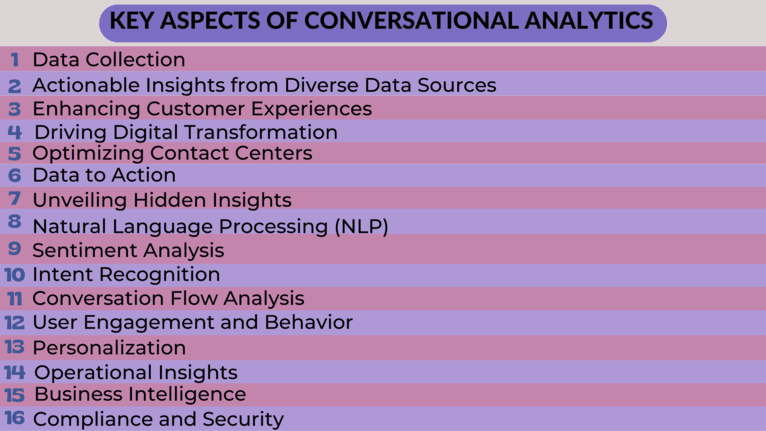Conversational Analytics
Conversational analytics is a field within data analysis that focuses on interpreting and understanding human conversations, particularly those that occur in digital communication channels such as chatbots, messaging apps, voice assistants, and social media platforms. It involves collecting, processing, and analyzing data from these conversations to derive insights and make informed decisions.
Key aspects of conversational analytics
Key aspects of conversational analytics include:
1. Data Collection
Conversational analytics gathers data from various sources, such as text messages, voice interactions, chat logs, social media conversations, and customer support interactions. This data is often unstructured and can include text, voice, images, emojis, and other forms of communication.
2. Actionable Insights from Diverse Data Sources
Conversational analytics doesn't just analyze customer feedback or surveys; it encompasses a wide range of data sources, including call recordings, chatbot conversations, and even social media interactions. Through speech analytics and text analysis, businesses can extract meaningful insights from these conversations, paving the way for data-driven decision-making.
3. Enhancing Customer Experiences
Conversational analytics leverages AI technologies to decode customer conversations through voice calls, chatbot interactions, or other digital channels. Businesses gain unparalleled insights into customer behaviors, sentiments, preferences, and pain points by analyzing the nuances of human speech and text. This level of understanding empowers organizations to tailor their products, services, and interactions to meet customer needs effectively.
Understanding customer conversations is paramount to delivering exceptional customer experiences in today's rapidly evolving business landscape. Every conversation is a valuable data source rich with potential insights, from call centers to digital interactions. This is where conversational analytics, powered by artificial intelligence (AI), offers a comprehensive understanding of customer interactions that can revolutionize customer experience management.
4. Driving Digital Transformation
In the realm of digital transformation, conversational analytics stands as a pivotal tool. It provides a real-time and historical view of customer interactions, enabling businesses to track customer journeys, identify pain points, and make iterative improvements. This ability to predict future customer behaviors and preferences based on past interactions is invaluable for crafting a seamless digital experience.
5. Optimizing Contact Centers
Conversational analytics technology acts as a game-changer for call and contact centers. It monitors agent performance, analyzes call records, and even tracks call outcomes. By offering a complete guide to agent-customer interactions, businesses can improve call center efficiency, enhance agent training, and ultimately increase customer satisfaction.
6. From Data to Action
The benefits of conversation analytics extend beyond customer interactions. Companies can fine-tune their product roadmap and drive sales enablement initiatives by understanding customers' feelings about a brand, product, or service. This data-driven approach ensures that every business decision is rooted in customer intelligence, leading to higher conversion rates and enhanced customer loyalty.
7. Unveiling Hidden Insights
Conversational analytics software watches over customer conversations like an attentive guardian, uncovering hidden gems of insights. It's like having an army of analysts working around the clock to analyze customer sentiment, behaviors, and experiences. These insights can improve customer service, refine marketing strategies, and guide overall business decisions.
8. Natural Language Processing (NLP)
NLP is a core component of conversational analytics. It uses computational techniques to understand and process human language, allowing machines to comprehend and respond to human communication. NLP helps extract meaning, sentiment, intent, and context from conversations.

9. Sentiment Analysis
This involves determining the emotional tone of a conversation, whether it's positive, negative, or neutral. Sentiment analysis can provide insights into customer satisfaction, brand perception, and overall sentiment trends.
10. Intent Recognition
Intent recognition focuses on identifying a user's message's underlying purpose or goal. Chatbots and virtual assistants must understand user intentions and provide relevant responses accurately.
11. Conversation Flow Analysis
Tracking the flow of a conversation helps identify patterns, common queries, frequently used responses, and potential bottlenecks in communication. This can lead to optimizing chatbot interactions and improving user experience.
12. User Engagement and Behavior
Conversational analytics can provide insights into user engagement levels, session durations, interaction frequency, and dropout rates. These metrics help evaluate the effectiveness of conversational interfaces.
13. Personalization
Businesses can personalize interactions based on user preferences, historical behavior, and context by analyzing conversational data. This enhances user satisfaction and builds stronger relationships.
14. Operational Insights
Conversational analytics can offer insights into the efficiency of customer support teams, including response times, issue resolution rates, and customer satisfaction scores.
15. Business Intelligence
The data collected from conversations can provide valuable insights for strategic decision-making, product development, marketing campaigns, and more.
16. Compliance and Security
In regulated industries, conversational analytics can help monitor and ensure compliance with industry standards and data protection regulations.
Conclusions
Conversational analytics has gained significant importance with the rise of AI-powered chatbots, virtual assistants, and the increasing use of messaging platforms for customer engagement. It enables businesses better to understand customer preferences, pain points, and behavior, improving communication strategies and user experiences.
In the fast-paced world of customer interaction, conversational analytics is the key to unlocking the potential of every conversation. From enhancing call center operations to optimizing digital experiences, this technology offers a comprehensive view of customer interactions, providing actionable insights that drive success.
So, whether it's about improving customer journeys, predicting future trends, or refining products, conversational analytics is a powerful tool that transforms conversations into business intelligence.